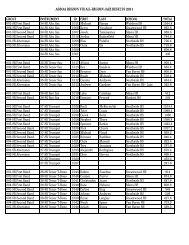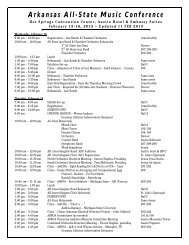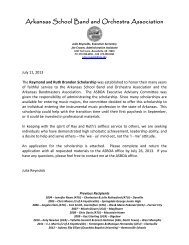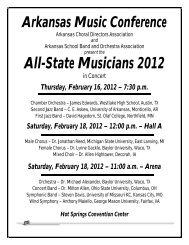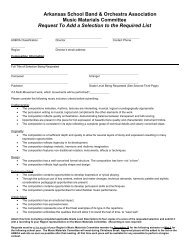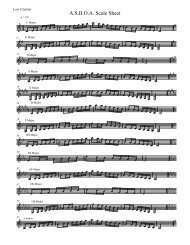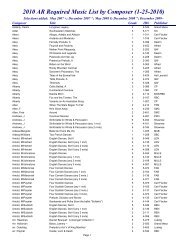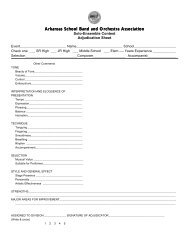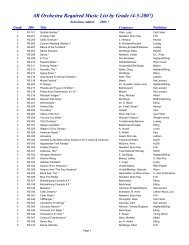Instrumental Music I - Arkansas Department of Education
Instrumental Music I - Arkansas Department of Education
Instrumental Music I - Arkansas Department of Education
You also want an ePaper? Increase the reach of your titles
YUMPU automatically turns print PDFs into web optimized ePapers that Google loves.
<strong>Instrumental</strong> <strong>Music</strong> IFine Arts Curriculum FrameworkRevised 2008
Course Title: <strong>Instrumental</strong> <strong>Music</strong> ICourse/Unit Credit: 1Course Number:Teacher Licensure:Grades: 9-12<strong>Instrumental</strong> <strong>Music</strong> I<strong>Instrumental</strong> <strong>Music</strong> I is a two-semester course designed to teach students music fundamentals and instrumental techniques pertaining to brass,woodwind, percussion, and/or string instruments. <strong>Instrumental</strong> <strong>Music</strong> I students are expected to develop beginning performance techniques insolo, small group, and large group settings, with emphasis on reading and performing using appropriate articulation, dynamics, and interpretiveskills. Students will perform instrumental music in a variety <strong>of</strong> settings including, but not limited to, concerts, solo and ensemble performances,and festivals. Students will critique and reflect on their own performances and the performances <strong>of</strong> others. Students will make connectionsbetween music traditions and other arts, disciplines, and cultures. Students will apply rudiments <strong>of</strong> music and fundamentals <strong>of</strong> creative expressionto performance and will demonstrate successful completion <strong>of</strong> <strong>Instrumental</strong> <strong>Music</strong> I student learning expectations. <strong>Instrumental</strong> <strong>Music</strong> I is requiredby the Standards for Accreditation and does not require <strong>Arkansas</strong> <strong>Department</strong> <strong>of</strong> <strong>Education</strong> approval.Strand Content StandardSkills and TechniquesCreative ExpressionCritical AnalysisConnections1. Students shall apply the essential skills and techniques to perform music.2. Students shall demonstrate creative expression through music.3. Students shall listen to, describe, analyze, perform, and evaluate music.4. Students shall make connections between music and other disciplines.1<strong>Instrumental</strong> <strong>Music</strong> IFine Arts Curriculum Framework Revised 2008<strong>Arkansas</strong> <strong>Department</strong> <strong>of</strong> <strong>Education</strong>
Strand: Critical AnalysisContent Standard 3: Students shall listen to, describe, analyze, perform, and evaluate music.CA.3.IMI.1Identify examples <strong>of</strong> a varied repertoire <strong>of</strong> music (e.g., classical, pop, jazz, marches)CA.3.IMI.2Demonstrate understanding <strong>of</strong> music notation and symbols by reading and performing musicCA.3.IMI.3Develop criteria for evaluating individual and group musical performancesCA.3.IMI.4Evaluate a performance, arrangement, or improvisation by comparing to exemplary modelsCA.3.IMI.5Exhibit proper etiquette in rehearsal, performances, and audience settings4<strong>Instrumental</strong> <strong>Music</strong> I: Critical AnalysisFine Arts Curriculum Framework Revised 2008<strong>Arkansas</strong> <strong>Department</strong> <strong>of</strong> <strong>Education</strong>Key: CA.3.IMI.1=Critical Analysis. Standard 3. <strong>Instrumental</strong> <strong>Music</strong> I. 1 st Student Learning Expectation
Strand: ConnectionsContent Standard 4: Students shall make connections between music and other disciplines.C.4.IMI.1Describe characteristics (e.g., setting, plot, historical significance) <strong>of</strong> program music (e.g., Peter and the Wolf, TheTempest, The Great Locomotive Chase, The Light in the Window)C.4.IMI.2Identify the role and function <strong>of</strong> instrumental music in lifelong learningC.4.IMI.3Identify musical traditions from a variety <strong>of</strong> culturesC.4.IMI.4Identify musical traditions that relate to other arts and other disciplines (e.g., Baroque, Romantic, non-Western)C.4.IMI.5 Describe cultural and technological influences on music (e.g., s<strong>of</strong>tware, hardware, recording, Web 2.0)C.4.IMI.6Demonstrate espirit de corps5<strong>Instrumental</strong> <strong>Music</strong> I: ConnectionsFine Arts Curriculum Framework Revised 2008<strong>Arkansas</strong> <strong>Department</strong> <strong>of</strong> <strong>Education</strong>Key: C.4.IMI.1=Connections. Standard 4. <strong>Instrumental</strong> <strong>Music</strong> I. 1 st Student Learning Expectation
Glossary for <strong>Instrumental</strong> <strong>Music</strong> IAccentsA stress or emphasis placed on a note generally performed one dynamic level higher at the beginning <strong>of</strong> thenote with space placed on each side <strong>of</strong> the noteAllegroFast, lively tempoAlternate fingeringsSubstitutions for traditional fingeringsAndanteModerately slow; a walking tempoArpeggiosBroken chordsArrangementAn altered compositionArticulationsThe correct attack and decay <strong>of</strong> soundAsymmetrical meterA meter or time signature that has any combination <strong>of</strong> two plus three beats per measure (e.g., , , )8 5 8 7 54BalanceThe equalization <strong>of</strong> soundsBaroque A musical period around 1600-1750BlendThe melding <strong>of</strong> sounds within a groupCantabileIn a singing styleChoralesReligious compositions originating in the 16 th Century Lutheran ChurchChordsSimultaneous combination <strong>of</strong> three or more different pitchesChromatic scaleA series <strong>of</strong> half stepsClassical A musical period around 1750 - 1830Compound meterBeat divisible by three rather than twoCrescendoGradually get louderDecrescendoGradually get s<strong>of</strong>terDolceSweetlyDynamicLoudness or s<strong>of</strong>tness <strong>of</strong> soundEnsembleGroup <strong>of</strong> two or moreEspirit de corpsThe morale <strong>of</strong> students that makes the members want to succeed as a groupEtiquetteProtocols for behavior during a rehearsal or a performanceEtudes<strong>Music</strong>al exercisesExpressionReferring to dynamics, tempo, and articulation in a compositionExpressive markingsSymbols used to indicate dynamics, tempo, and articulation in a compositionForte (f)LoudFortissimo (ff)Very loudGrandiosoMajesticGraveSerious6<strong>Instrumental</strong> <strong>Music</strong> I: GlossaryFine Arts Curriculum Framework Revised 2008<strong>Arkansas</strong> <strong>Department</strong> <strong>of</strong> <strong>Education</strong>
HardwareImprovisationImprovise<strong>Instrumental</strong> pitch tendenciesInternalizing beatIntonationJazzLegatoLentoLip slursMaestosoMajor scaleMarcatoMarchesMelodicMeterMezzo forte (mf)Mezzo piano (mp)Minor scaleModeratoNotationNotesOctavesOverturesPhrasingPianissimo (pp)Piano (p)PerformancePopPreparatory beatPrestoProgram musicComputer interface devices, such as microphones, speaker systems, cameras, MP3 players, electronicinstruments, and interactive whiteboardsSpontaneous performance <strong>of</strong> musicTo create spontaneouslyUnique characteristics <strong>of</strong> an instrument which effect pitchFeeling the musical pulseDegree <strong>of</strong> accuracy in which pitches are played in tuneAn American musical style blending European and African influencesSmooth and connectedSlowMoving smoothly between two notesDignifiedA sequence <strong>of</strong> eight notes arranged in the following specific pattern <strong>of</strong> whole and half steps, beginning andending with the tonic: tonic, whole step, whole step, half step, whole step, whole step, whole step, half step totonicMarked, accentedMilitary styleRelating to melody, which is the tune or a series <strong>of</strong> pitches that moves up or down, or stays the sameA pattern <strong>of</strong> fixed beats as indicated by time signatureModerately loudModerately s<strong>of</strong>tHas the same tones as the major scale, but uses the sixth tone <strong>of</strong> the major scale as its tonic, resulting in thefollowing pattern: tonic, whole step, half step, whole step, whole step, half step, whole step, whole step to tonicModerate tempoA system used for writing musicSymbols used to indicate pitch and/or durationAn interval spanning seven diatonic degrees or eleven half stepsA musical introduction in a play, opera, or balletObserving the musical sentenceVery s<strong>of</strong>tS<strong>of</strong>tTo play, sing, or move in formal or informal settingsA modern style <strong>of</strong> music characterized by its popularityConducting gestureFast tempo<strong>Music</strong> that depicts a story or inspires visual images7<strong>Instrumental</strong> <strong>Music</strong> I: GlossaryFine Arts Curriculum Framework Revised 2008<strong>Arkansas</strong> <strong>Department</strong> <strong>of</strong> <strong>Education</strong>
RecordingReproducing sound using computer-based audio, video, and stand alone sound systems (e.g., portable,component)RegistersPitch rangesRepertoireList <strong>of</strong> music pieces which a group or person has prepared or performedRhythmic patternsA specific grouping <strong>of</strong> rhythms used in teaching, reading, and writing musicRhythmicRelated to rhythm, which is the pattern <strong>of</strong> long and short sounds and silences in musicRomantic A musical period around 1815-1915RudimentsRhythmic patterns used as exercisesScalesAscending or descending patterns <strong>of</strong> whole and half stepsSight-readReading a piece <strong>of</strong> music without preparationSimple meterAccented beats <strong>of</strong> each measure divisible by twoSlurring patternsSpecific grouping <strong>of</strong> slurs used as teaching exercisesS<strong>of</strong>twareComputer-based programs for notating, arranging, synthesizing, and otherwise manipulating musicStaccatoShort and detachedStyleA characteristic <strong>of</strong> a particular period, person, or group <strong>of</strong> people that make genres <strong>of</strong> music unique (e.g., folk,symphony)SuitesA set <strong>of</strong> short pieces in dance form that can stand alone or as a groupSymbolsSignsSyncopationRhythmic effect which places emphasis on a weak or <strong>of</strong>f beatTechnologicalA term relating to computers, sound systems, projectors, the Internet, and other modern communication toolsTempiPlural for tempo, which is the speed <strong>of</strong> the beatTempo changesAlterations in the speed <strong>of</strong> the beatTenutoSustain notes for full valueThirdsAn interval <strong>of</strong> one-and-a-half or two stepsToneA musical sound on a specific pitchTonguingUsing the tongue to articulate notesTripletsRhythmic groupings <strong>of</strong> threeTubing lengthAdjustments made to an instrument that affect intonationVertical alignmentEnsemble precisionWeb 2.0Interactive, user-created World Wide Web content, such as Podcasts, blogs, Wikis, and mashups8<strong>Instrumental</strong> <strong>Music</strong> I: GlossaryFine Arts Curriculum Framework Revised 2008<strong>Arkansas</strong> <strong>Department</strong> <strong>of</strong> <strong>Education</strong>



